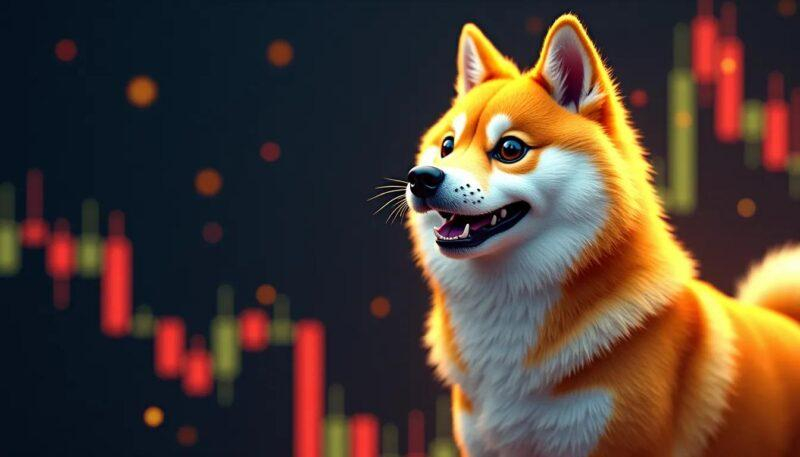In the ever-shifting seas of cryptocurrency, Dogecoin has carved out a unique place-part meme, part market mover, and entirely unpredictable. For investors and enthusiasts alike, riding the waves of Dogecoin’s price fluctuations can feel like navigating a stormy ocean without a map. Yet, within these dips lie opportunities waiting to be charted with insight and strategy. This article delves into smart approaches for weathering Dogecoin downturns, offering a steady compass amid the volatility and guiding you toward informed decisions when the tides turn.
Understanding Dogecoin Market Fluctuations and Their Causes
Dogecoin’s value often dances with the rhythm of social sentiment and external influences rather than typical market fundamentals. Unlike traditional assets, its price can be jolted by a single viral tweet or a celebrity’s subtle nod. These sudden spikes or drops reflect the coin’s community-driven nature, making it highly sensitive to shifts in public perception. Understanding this makes it clear why Dogecoin can surge on seemingly random days and dip just as unpredictably.
Several key factors play a role in shaping Dogecoin’s rollercoaster ride:
- Social Media Buzz: Platforms like Twitter and Reddit act as major catalysts, with trending memes or news influencing millions.
- Market Speculation: Investors often treat DOGE as a speculative asset, leading to rapid inflows and outflows chasing quick profits.
- Macro Crypto Trends: Movements in Bitcoin and Ethereum often ripple into altcoins like Dogecoin, amplifying volatility.
- Regulatory News: Legal developments worldwide can either spark enthusiasm or fuel fear in the market.
To put this in perspective, the table below summarizes recent factors alongside their typical market impact:
| Influence | Market Impact | Volatility Level |
|---|---|---|
| Elon Musk Tweets | Price surges or sharp dips | High |
| Crypto Market Corrections | Downward pressure across altcoins | Medium |
| New Exchange Listings | Increased liquidity and interest | Medium-High |
| Regulatory Announcements | Sudden uncertainty or optimism | High |
Identifying Key Indicators for Timing Your Entry During Dips
Timing your move into Dogecoin dips is as much an art as it is a science. Savvy investors watch for volume spikes-sudden increases in trading activity that often signal a potential reversal. When volume surges alongside a price drop, it can indicate that the dip is attracting buyers and that the market may be ready to bounce back. Conversely, low volume during a dip might signal weak interest and further downside risk.
Another vital sign to monitor is the position of Dogecoin relative to its simple moving averages (SMA). Crossing below key moving averages like the 50-day or 200-day SMA is often perceived as a bearish indicator, but it can also mark oversold territory ripe for entry. Coupling this with momentum oscillators such as the Relative Strength Index (RSI)-especially when it dips below 30-can provide confirmation that Dogecoin is undervalued in the short term.
Combine these indicators effectively by tracking:
- Volume spikes paired with price action
- Interaction with 50-day and 200-day SMA
- RSI staying below 30 indicating oversold conditions
- News catalysts that might cause sudden sentiment shifts
| Indicator | Signal Type | What to Watch For |
|---|---|---|
| Volume | Bullish Reversal | Spike when price dips |
| 50-day SMA | Support/Resistance | Price bounce after dip below |
| RSI | Oversold Indicator | Readings below 30 |
| News | Sentiment Shift | Positive market-moving events |
Risk Management Techniques to Protect Your Investment
Volatility is the heartbeat of Dogecoin’s market, and navigating its unpredictable tides requires more than just intuition-it demands a toolkit of smart approaches to safeguard your trading capital. One of the foundational methods is setting clear stop-loss orders. By predetermining the maximum loss you’re willing to accept, you prevent emotional decision-making that could escalate losses during sudden dips. This tactical boundary helps you exit positions swiftly before the market turns against you too deeply.
An equally valuable technique is portfolio diversification. Placing all your eggs in Dogecoin’s basket might spike potential returns but also magnifies risk exposure. By allocating a portion of your investments to other cryptocurrencies, stablecoins, or even traditional assets, you create a buffer against Dogecoin’s high volatility. This multi-asset approach balances opportunity and security, ensuring you don’t ride the waves alone.
Lastly, employing a disciplined approach to dollar-cost averaging (DCA) can smooth out the impact of price fluctuations. Instead of trying to time the market perfectly, consistently invest fixed amounts at regular intervals. This method averages your purchase price, mitigating the risk of investing a lump sum at a market peak. To illustrate, here’s a quick snapshot of how DCA stacks up against lump-sum investing over a typical Dogecoin dip:
| Method | Investment Timing | Risk Level | Potential Upside |
|---|---|---|---|
| Dollar-Cost Averaging | Spread over weeks/months | Lower | Moderate, steadier gains |
| Lump-Sum Investing | One-time at market entry | Higher | High if timed well, big loss if not |
- Stop-Loss Orders: Automated safety nets against heavy losses
- Diversification: Balancing volatile assets with stable ones
- Dollar-Cost Averaging: Smoothing out market entry points
Leveraging Dollar-Cost Averaging for Steady Portfolio Growth
When navigating the volatile waters of Dogecoin, embracing a systematic investment approach can be a game-changer. Instead of attempting to time the market perfectly, dollar-cost averaging (DCA) allows investors to consistently purchase Dogecoin at regular intervals, regardless of price fluctuations. This method cushions the impact of sudden dips by spreading out purchases – turning market dips into strategic entry points.
By committing to invest a fixed amount of money weekly or monthly, you naturally buy more Dogecoin when prices are low and less when prices soar, ultimately averaging out the cost per coin over time. This disciplined habit removes emotional decision-making from the equation, which is especially critical when crypto prices swing wildly. Plus, it instills a mindset focused on long-term growth rather than reacting to day-to-day market noise.
- Reduces the risk: Minimizes the chance of investing a lump sum at an unfavorable high.
- Builds consistency: Encourages patience and steady accumulation instead of erratic trades.
- Simplifies investing: No need for constant market monitoring or guesswork.
| Investment Cycle | Lot Size | Avg. Price Bought | Total Doge Accumulated |
|---|---|---|---|
| Week 1 | $100 | $0.30 | 333.3 DOGE |
| Week 2 | $100 | $0.25 | 400 DOGE |
| Week 3 | $100 | $0.28 | 357.1 DOGE |
| Total | $300 | – | 1,090.4 DOGE |
Over time, this steady accumulation strategy empowers you to avoid the pitfalls of impulsive investing and results in a more balanced, resilient portfolio. Leveraging dollar-cost averaging means you’re not chasing the market but rather riding its waves with confidence and clarity, turning volatility into opportunity on your Dogecoin journey.
Exploring Diversification Strategies Beyond Dogecoin
When navigating the unpredictable tides of cryptocurrency, it’s vital to look beyond a single asset like Dogecoin and explore a spectrum of diversification options. Instead of putting all your eggs in one crypto basket, consider blending various digital currencies that offer unique value propositions. For example, pairing more established coins like Bitcoin or Ethereum with emerging altcoins can balance out the high volatility associated with memecoins, smoothing your portfolio’s overall performance.
Diversification isn’t limited to crypto assets alone. Many savvy investors integrate traditional assets such as stocks, bonds, or even commodities into their strategy. These non-correlated investments can act as buffers during Dogecoin downturns, cushioning the impact of sudden dips while maintaining growth potential. Here’s a quick glimpse at how mixing assets can stabilize a portfolio:
| Asset Type | Volatility Level | Typical ROI | Role in Portfolio |
|---|---|---|---|
| Dogecoin | High | Variable | Growth & Speculation |
| Bitcoin | Medium | Moderate | Store of Value |
| Stocks | Low to Medium | Steady | Wealth Preservation |
| Bonds | Low | Stable | Risk Mitigation |
Beyond pure asset diversification, think about diversifying your investment approach. A mix of dollar-cost averaging, staking, or even yield farming can open up alternative streams of income while mitigating timing risks of volatile dips. With this layered strategy, dips in Dogecoin aren’t just pitfalls-they become opportunities to leverage your broader investment portfolio and grow smarter over time.
Q&A
Q&A: Riding the Waves: Smart Strategies for Dogecoin Dips
Q1: What makes Dogecoin dips different from other cryptocurrency drops?
A1: Dogecoin’s dips often feel like a tidal wave fueled by social media currents and meme culture rather than just market fundamentals. Unlike more established coins, Dogecoin’s price swings can be dramatically impacted by viral moments, celebrity tweets, and community hype, making its dips uniquely volatile and unpredictable.
Q2: Why should investors consider developing strategies specifically for Dogecoin dips?
A2: Because Dogecoin is prone to sharp and sudden price swings, having a tailored strategy ensures investors don’t simply react emotionally. Smart strategies help navigate the noise, minimize losses, and position for potential rebounds-turning volatile dips into potential opportunities rather than pitfalls.
Q3: What is a key mindset to adopt when facing a Dogecoin dip?
A3: Patience is paramount. Viewing dips not as catastrophic losses but as natural waves within Dogecoin’s bumpy sea encourages calm decision-making. Remember, riding the waves means acknowledging that downturns are part of the journey-sometimes the best moves happen while waiting for the tide to rise again.
Q4: Are there any practical tactics to manage Dogecoin dips effectively?
A4: Absolutely. Dollar-cost averaging stands out as a classic tactic-investing fixed amounts regularly helps smooth out the impact of dips. Diversification across assets can reduce risk exposure, while setting predetermined stop-loss orders can limit potential downsides. Monitoring community trends and news also provides clues when a dip might signal a deeper correction or a fleeting drop.
Q5: How can one identify if a Dogecoin dip is a buying opportunity or a warning sign?
A5: Context is key. Analyzing market sentiment, trading volumes, and broader crypto market trends alongside Dogecoin’s quirky social dynamics is essential. If a dip follows a hype burst or viral event with no underlying negative news, it might be a buying opportunity. Conversely, if the downfall coincides with widespread market sell-offs or regulatory concerns, caution is warranted.
Q6: Should casual investors be involved in Dogecoin trading during dips?
A6: It depends on one’s risk tolerance and investment goals. Dogecoin’s playful spirit attracts many casual investors, but its erratic waves can challenge even seasoned traders. Those drawn in should only invest what they can afford to lose and consider Dogecoin a high-risk part of a broader, balanced portfolio.
Q7: What’s the takeaway message for navigating Dogecoin dips wisely?
A7: Treat Dogecoin as a ride on unpredictable waves-equipped with smart strategies, a steady mindset, and informed vigilance, dips become less daunting. Embrace the volatility, plan your moves, and remember that every wave, no matter how rough, eventually crests again.
Closing Remarks
As the tides of the crypto market ebb and flow, navigating Dogecoin’s dips with thoughtful strategies can transform uncertainty into opportunity. Like a seasoned surfer reading the waves, informed decisions and a steady mindset help you ride out volatility with confidence. Whether you’re holding for the long haul or seeking the next entry point, embracing these smart approaches ensures you’re not just caught in the currents-but skillfully steering through them. In the ever-changing sea of Dogecoin, it’s not about avoiding the dips, but mastering how you respond when they come.





